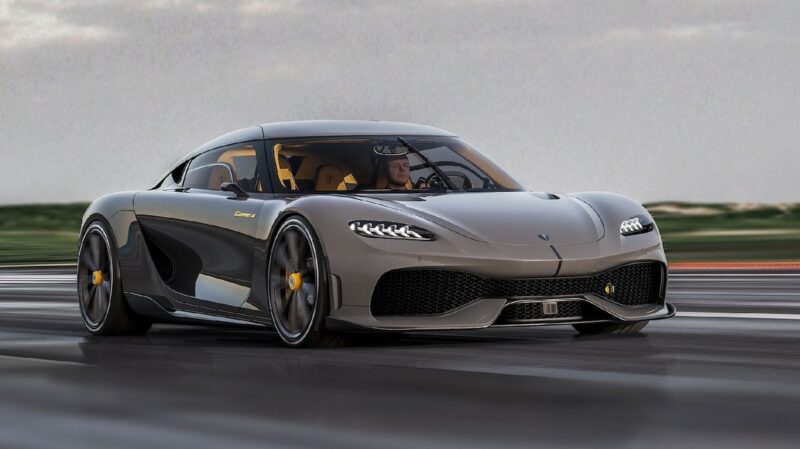Once upon a time, real production cars with over 1,000 hp were quite difficult to find.
However, with current technological advancements, it has now become commonplace for every manufacturer to compete in producing cars capable of unleashing up to two thousand horsepower, whether internal combustion engine or electric-powered.
As long as more advanced technologies exist, the race for the highest horsepower will not cease.
Below is a list of the most powerful new production cars that exist on this planet:
1. Koenigsegg Gemera
The Koenigsegg Gemera is a four-seater grand tourer equipped with a 5.0-liter hybrid V8 engine capable of generating up to 2,300 hp and 2,750 Nm of torque.
Looking for a less powerful version? You can opt for the inline-three-cylinder 2.0-liter hybrid variant, with a total output of 1,400 hp and 1,800 Nm of torque.
Even this might not be produced by Koenigsegg in the near future, as the majority of Gemera owners prefer the V8 engine.
2. Lotus Evija
Lotus, well-known for its lightweight cars, has ventured into producing electric sports/supercars.
Introduced in 2019, the Evija features four electric motors, each producing 503 PS of power, with a total power output of 2,011 hp and 1,704 Nm of torque.
This limited-production sports car can travel a distance of up to 346 km, thanks to its 93 kWh battery pack.
3. Aspark Owl
Despite its name not sounding Japanese, the Aspark Owl is actually an electric sports car developed by the engineering firm Aspark from the Land of the Rising Sun.
With four electric motors (one for each wheel), the Aspark Owl can deliver 1,984 hp and 2,000 Nm of torque.
Its 69 kWh battery pack allows it to travel up to 451 km on a single full charge.
4. Pininfarina Battista
Another powerful electric supercar on the list produced by Automobili Pininfarina GmbH.
It is also powered by four electric motors with a combined output reaching 1,900 hp and 2,300 Nm of torque.
A full battery charge enables this car to travel up to 450 km.
5. Rimac Nevera
This Rimac-built supercar shares the same factory used to assemble the Pininfarina Battista.
The Rimac Nevera is equipped with four electric motors driving each wheel, producing 1,888 hp and 2,360 Nm of torque, achieving a top speed of 412 km/h – one of the fastest EVs in the world.
6. Hennessey Venom F5
Hennessey Special Vehicles began producing the Venom F5 sports car in 2020, offering various options to its customers.
Regardless of the sold-out versions or the Roadster version currently being produced, each unit comes with a twin-turbocharged 6.6-liter V8 engine, generating up to 1,817 hp and 1,617 Nm of torque.
Maximum speed? Over 500 km/h!
7. Bugatti Tourbillon
The Bugatti Tourbillon is a hybrid sports car set to be produced starting from 2026.
Limited to only 250 units, the Bugatti Tourbillon features a V16 engine with a displacement of 8,355 cc paired with three electric motors.
The engine alone can produce 986 hp/900 Nm, but with the help of the electric motors, the Tourbillon can reach a power output of 1,775 hp and 3,000 Nm.
0-100 km/h in just 2.0 seconds, followed by 0-200 km/h in under five seconds, while 0-400 km/h is accomplished in less than 25 seconds before reaching a top speed of 380 km/h.
8. Koenigsegg CC850
Built as a tribute to the CC8S model, the Koenigsegg CC850 is a limited-production car celebrating the 50th birthday of its founder, Christian von Koenigsegg.
Borrowing the twin-turbocharged 5.0-liter V8 engine from the Jesko model, the CC850 outputs 1,385 hp and 1,385 Nm, or 1,185 hp when using regular fuel.
9. SSC Tuatara
The SSC Tuatara was originally powered by a twin-turbocharged 6.9-liter V8 engine, but the engine capacity has been reduced to 5.9 liters to allow it to reach a higher redline (8,800 rpm).
According to SSC, the Tuatara is capable of producing up to 1,350 hp and 1,735 Nm of torque, or up to 1,750 hp when using E85 fuel.
10. Czinger 21C VMax
The car in this final list is produced by the American automotive manufacturer, Czinger Vehicles.
The 21C is essentially a hybrid sports car with a 2.88-liter V8 engine paired with three electric motors, delivering 1,250 hp and 1,830 Nm of torque.
Acceleration from 0-96 km/h takes just 1.9 seconds before reaching a maximum speed of 407 km/h!
